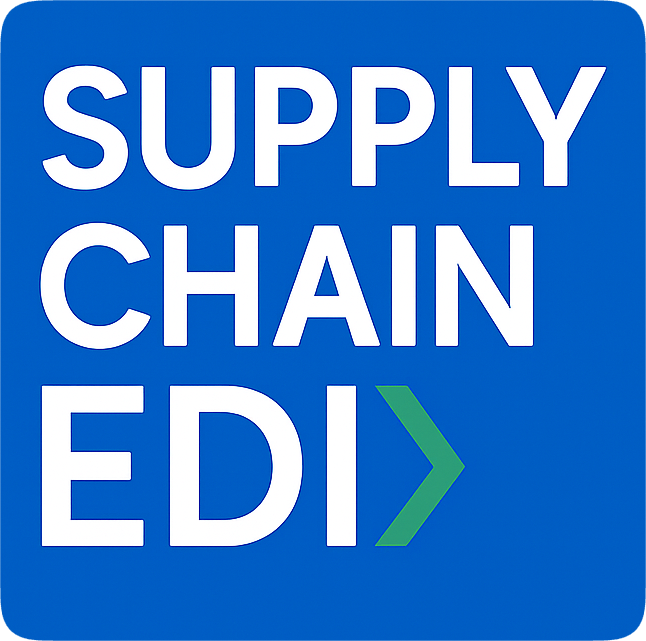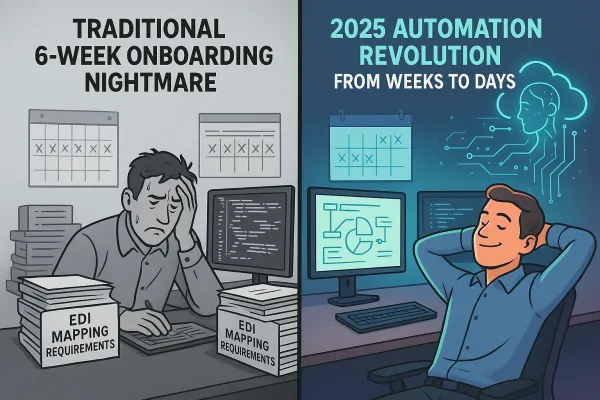The Scope 3 Emissions Data Crisis: How EDI Automation Solves the Supply Chain Sustainability Reporting Challenge Facing 70% of Companies in 2025

Companies with revenues over $1 billion doing business in California must begin gathering emissions data in 2025 to meet the Climate Corporate Data Accountability Act reporting requirements starting in 2026. Meanwhile, the EU's Corporate Sustainability Reporting Directive requires large companies to report for their 2024 financial year, with reports due in 2025.
Here's what most people miss: Scope 3 emissions account for 75% of a company's overall emissions on average, yet organizations struggle to track these emissions due to the intricate web of supplier and customer relationships. According to the GHG Protocol, 83% of companies struggle to access accurate emissions data, and poor data quality and availability across the supply chain is the main obstacle, with supply chain partners often lacking good-quality primary data.
The Scope 3 Emissions Reporting Crisis: Why 70% of Companies Are Unprepared
Indirect emissions that occur along a company's value chain account for 75% of the organization's overall emissions, on average. They remain difficult to track. Despite this massive impact, data collection remains the biggest challenge, with 83% of companies struggling to access accurate emissions data according to the GHG Protocol.
The regulatory timeline is unforgiving. California's SB 253 requires reporting entities to disclose Scope 1 and 2 emissions starting in 2026 and Scope 3 emissions starting in 2027. Enterprises will need to report on their 2025 direct and indirect emissions starting June 30, 2026, and companies must begin gathering emissions data in 2025 to meet reporting requirements.
Sound familiar? We've found that as much as 80% of an organization's supply chain emissions come from as few as one-fifth of its purchases. At one public-sector agency, just 20 suppliers were responsible for 94% of the agency's Scope 3 emissions.
The Manual Data Collection Trap
The calculation of Scope 3 emissions requires personnel, resources, expertise, and efficient data management processes, which can be difficult to align across a company's supply chain. The complexity of multi-tier supply chains creates dependencies where organizations must rely on direct suppliers to provide information about their suppliers. Even when data is available, collecting, verifying, and analyzing it requires substantial effort, often necessitating a dedicated team.
Data availability challenges include limited transparency and traceability across value chains, plus companies often have complex value chains with many suppliers and customers, making it challenging to accurately account for all scope 3 emissions.
Each partner in the supply chain bases their calculations on estimations like emission factors, industry averages, and fuel-based or spend-based calculations. Such estimations of estimations can make data extremely complex in large value chains.
EDI Automation: The Hidden Solution to Supply Chain Carbon Tracking
Here's where EDI becomes your secret weapon. EDI helps businesses consolidate shipments, optimize routes, and reduce unnecessary transportation, leading to lower fuel consumption and carbon emissions.
By automating inventory updates and demand forecasting, EDI reduces waste and promotes more sustainable inventory management. EDI-integrated transportation planning ensures trucks and cargo containers operate at optimal capacity, reducing partial-load shipments, while real-time visibility allows businesses to adapt shipping routes based on demand.
The environmental benefits go deeper. By using digital, automated processing, companies are more efficient and eco-friendly because they eliminate the need for expensive, slow, and error-prone manual labor, as well as reliance on paper-centric processing. Transitioning to EDI eliminates the need for printing purchase orders, invoices, and shipping notices.
Real-Time Emissions Data Through EDI Transaction Flows
Carriers use EDI to send advanced shipment notifications (ASN) to shippers and customers, providing real-time updates on the status and location of shipments. This creates a foundation for carbon tracking that most companies haven't recognized yet.
Notice the pattern? EDI 856 Advanced Ship Notices already contain weight, distance, and transportation mode data. When integrated with carbon calculation engines, these transactions become automatic emissions calculators. Carriers with steadier utilization and speed profiles help shippers reduce the risk of extreme carbon spikes.
Integrating EDI with TMS creates a powerful solution that enhances visibility and control throughout the supply chain. These solutions streamline freight management, optimize supply chain workflows, and enhance visibility, reducing errors and improving efficiency.
The TMS-EDI Integration Framework for Automated Scope 3 Collection
The practical implementation involves connecting your transportation management system with EDI-enabled carbon tracking. Major TMS platforms including MercuryGate, Descartes, Transporeon, nShift, Manhattan Active, Blue Yonder, Oracle TM, SAP TM, and Cargoson can integrate with EDI platforms to automatically capture transportation emissions data.
Transportation Management Systems manage transportation operations, including route planning, carrier management, load planning and consolidation. EDI integration with the TMS ensures accurate and timely data exchange, enabling efficient order fulfillment processes and transportation management.
Here's what most implementations miss: Carbon footprint monitoring at both shipment and fleet levels enables businesses to advance their sustainability accounting. Systems handle EDI, CSV, XML, JSON formats for smooth data exchange, while measuring and managing carbon footprint for supply chain sustainability and efficiency.
The data flows work like this: EDI 204 Load Tender contains route and weight information. EDI 214 Transportation Carrier Shipment Status Message tracks actual routes taken. EDI 210 Motor Carrier Freight Details and Invoice provides fuel consumption data. When processed through carbon calculation algorithms, these become real-time emissions reports.
Overcoming the Supplier Data Gap Challenge
Engaging stakeholders across the value chain is essential for obtaining Scope 3 emissions data but can be challenging when partners do not measure their emissions or face difficulties improving their measurement. Even for those that have data available, concerns about trust, confidentiality, intellectual property, or reputation can make them reluctant to share it.
EDI solves this through standardization. Instead of custom questionnaires or one-off data requests, suppliers provide carbon data through standard EDI transactions they're already using. Because EDI is a widely adopted standard, it facilitates communication between companies using different systems internally. EDI allows businesses to exchange information 24/7, multiple times per day, and with API integration, companies can exchange information near-instantaneously.
The European Union has introduced its Corporate Sustainability Reporting Directive which captures US businesses doing business in the EU. US companies with annual revenue exceeding $1B that do business in California face emissions disclosure requirements. This creates a cascade effect where large companies require emissions data from their entire supplier network.
Implementation Roadmap: From Crisis to Compliance in 90 Days
Phase 1 (Days 1-30): Current state assessment involves auditing existing EDI connections and identifying which trading partners already exchange transportation documents. Map your top 20 suppliers by spend – these likely represent 80% of your Scope 3 emissions. We've typically found that as much as 80% of an organization's supply chain emissions come from as few as one-fifth of its purchases.
Phase 2 (Days 31-60): Deploy carbon tracking EDI extensions. This means enhancing existing EDI 856 ASNs with carbon intensity factors and modifying EDI 810 Invoices to include emissions data. Major EDI platforms like IBM Sterling, SPS Commerce, TrueCommerce, and Cleo can handle these enhancements without disrupting existing workflows.
Phase 3 (Days 61-90): Validation and optimization. Companies will be required to hire independent auditors to verify their reported emissions, making rigorous carbon accounting absolutely critical. Companies will need to handle their climate data with similar care as financial data, implementing internal processes and controls over collection and reporting.
The cost comparison is stark. Manual Scope 3 data collection typically costs $200-500 per supplier annually. EDI automation brings this down to $20-50 per supplier after the initial setup investment of $50,000-150,000 for most mid-market companies.
Technology Stack and Vendor Selection
Your EDI platform needs carbon calculation capabilities. IBM Sterling B2B Integrator can integrate with carbon accounting APIs. SPS Commerce offers sustainability modules for their cloud EDI platform. TrueCommerce provides carbon tracking extensions for transportation documents. Cleo Integration Cloud supports custom carbon data fields in standard EDI transactions.
For TMS integration, platforms like Cargoson already include sustainability tracking features that work seamlessly with EDI carbon data exchange. EDI solutions seamlessly integrate with all major Transportation Management Systems, ensuring smooth data exchange between carriers, shippers, and logistics partners, whether you need fully integrated EDI for end-to-end automation or cloud-based solutions for flexible transactions.
Automated supply chain carbon accounting helps companies tackle climate risks, reduce emissions, and accelerate the transition to a net-zero economy while meeting customer demand for carbon data and generating product carbon footprints. This provides transparency to banks and meets sustainability criteria for Scope 1, 2 and 3 data.
Future-Proofing Your Supply Chain for Evolving ESG Requirements
Under proposed value chain sustainability reporting, companies would be required to report scope 3 emissions. These indirect emissions result from upstream and downstream activities and are notoriously tricky to measure – it's not an overnight process, so companies should begin as soon as possible.
The regulatory landscape keeps expanding. Europe has enacted the Corporate Sustainability Reporting Directive that phases in Scope 3 disclosures over coming years for companies meeting certain criteria. California passed climate disclosure bills covering Scope 3 that could impact more than 10,000 public and private companies.
Using API is favorable for its flexibility, speed and sustainable upkeep. More companies are leaning towards API connections, which means that resourcing for EDI will minimize over the next 10 years. APIs are the more future-proofed option if you have the choice. But here's the reality: EDI is still widely used in the transportation industry, and that's not likely to change anytime soon.
The smart approach combines both. Use EDI for standardized carbon data exchange with your established trading partners while building API connections for real-time carbon tracking with newer suppliers. Both EDI and API can position companies for supply chain success. They can collaborate to provide greater context to integrations within a digital ecosystem. Utilizing the capabilities of either within a single TMS strengthens data exchange capabilities.
Your next step: audit your current EDI connections this week. Identify which suppliers already send you EDI 856 ASNs or EDI 214 status messages. These are your quickest wins for automated carbon data collection. Start there, expand gradually, and you'll have automated Scope 3 emissions tracking before your competitors figure out they need it.





